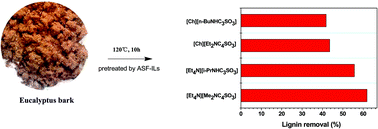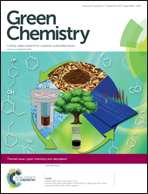Fractionation of lignin from eucalyptus bark using amine-sulfonate functionalized ionic liquids†
Abstract
A series of amine-sulfonate functionalized ionic liquids (ASF-ILs) were synthesized, characterized, and evaluated for the dissolution of model biopolymers (cellulose, xylan, kraft lignin and lignosulfonate). The ASF-ILs were prepared in high atomic efficiency. Most of the ASF-ILs dissolve kraft lignin and lignosulfonate efficiently at 373 K, with solubilities of 0.220–0.385 g for kraft lignin and of 0.150–0.290 g for lignosulfonate per gram of ASF-ILs. In contrast, xylan and cellulose are scarcely soluble (<5 mg g−1) in the ASF-ILs. Based on the results of the model lignin dissolution, four most promising ASF-ILs were selected and applied for the pretreatment of eucalyptus bark. The lignin was selectively fractionated by the ASF-ILs (393 K for 10 h, lignin removal was more than 40%). The fractionated lignin and the eucalyptus bark residues were then characterized by infrared spectroscopy and thermogravimetric analysis. Importantly, we demonstrate that enzymatic hydrolysis of the polysaccharide components of the eucalyptus bark to sugars was substantially enhanced after the pretreatment, most pronouncedly with the ASF-IL[Et4N][Me2NC4SO3].

- This article is part of the themed collection: Lignin chemistry and valorisation

 Please wait while we load your content...
Please wait while we load your content...